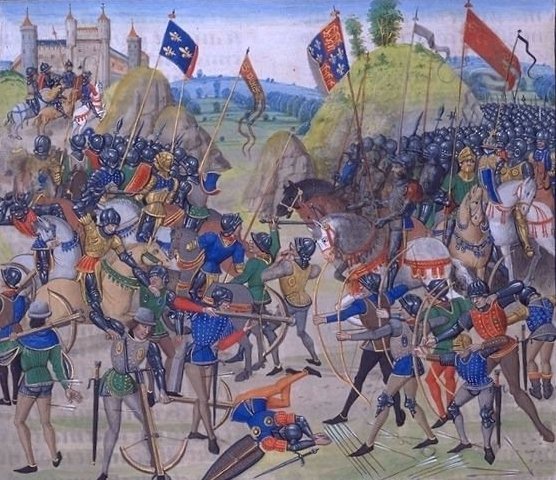Posts: 2,121 Location: Northern Utah
Wed 21 Jan, 2009 12:41 pm
Steven,
It is not just the artwork but the text as well. Froissart was copied over and over again as many people wished to own copies. We have several different versions of Froissart in existence. Many of the later ones are copies of editions he wrote earlier. Since they were hand done each is different in artwork but the text will follow one of Froissart’s chronicles. I think there are over 5 versions.... something saying 6 but I cannot remember and do not have the book in hand to verify. Needless to say the events stop c. 1400 but the existent editions are mostly from after the date of his death.
From Harvard Classics intro (italics are my own)
‘JEAN FROISSART, the most representative of the chroniclers of the later Middle Ages, was born at Valenciennes in 1337. The Chronicle which, more than his poetry, has kept his fame alive, was undertaken when he was only twenty;
the first book was written in its earliest form by 1369; and he kept revising and enlarging the work to the end of his life. In 1361 he went to England, entered the Church, and attached himself to Queen Philippa of Hainault, the wife of
Edward III, who made him her secretary and clerk of her chapel. Much of his life was spent in travel. He went to France with the
Black Prince, and to Italy with the Duke of Clarence. He saw fighting on the Scottish border, visited Holland, Savoy, and Provence, returning at intervals to Paris and London. He was Vicar of Estinnes-au-Mont, Canon of Chimay, and chaplain to the Comte de Blois; but the Church to him was rather a source of revenue than a religious calling. He finally settled down in his native town, where he died about 1410.’
Here is Wiki- cannot say how sound it is but some more info. Claims there are over 100 of Froissart's chronicle around in some form and that there are 4 different books each later one including a bit more with some changes to earlier sections.
http://en.wikipedia.org/wiki/Froissart's_Chronicles
Dan,
There are a few instances where 1000lbers are used in field combat. Supposedly Edward II employed them and springalds in his Scot campaigns and in the war of St. Sardos but I have not followed the secondary sources up to make sure. I know he brought something like 200 springlads of 2 sizes there so that is possible. Very few field battles took place in St. Sardos, though there are some fights outside fortifications.
Since no one has done much research into the total weight to draw weight of crossbows I do not know what the real relationship is. This is all I could find off hand. Leibel states that the great crossbows (well over 2000lb draw) were 100-200 pounds, the difference being steel prod to composite. Estimates on the average 1 foot crossbow to 770lbs(horn)-990lbs(steel), 2 foot crossbow 1760lb (per Harmuth). The latter two types being hand held though Leibel states that the two foot crossbow was more often used outside fortresses that the larger types (springalds and great crossbows) it could not have been carried over too great of distances by one man as the smallest type could. So according to Harmuth and Liebel yes over 1000 was not uncommon. The one foot crossbows (smallest) being not far off from 1000lbs. It seems to me that the averages that both Liebel and Harmuth use could be seen on the high side if not upper end but I have not had the privilege of handling so many period crossbows as both Liebel and Harmuth have. Those I have seen were steel prod and usually 16th century but were not massively heavy and estimated to have been 600-800lbs. Not much help but the best I have. I do not have a copy of The Crossbow handy to see what P-G has to say about it.
Gary,
I do not doubt that the large crossbows on the ships were the larger great crossbows that Liebel talks of. He states 1760lbs as their average (see above) draw weight. Philip the Good, Charles the Bold father required a great number of large crossbows on his naval fleet as well (more than firearms actually into the 2nd half of the 15th). I think is at close range they'd be very likely to pierce armour but it seems great crossbows also were used early on in naval engagements to 'soften' the enemies up. I am not sure what the distance would be but Liebel gives the impact at 1782 joules though I cannot find his given distance. Under this amount of energy I think it would have a very high probability of defeating armour.
Springalds and Great Crossbows is really worth the read. Only Ł10 from the RA!
RPM
